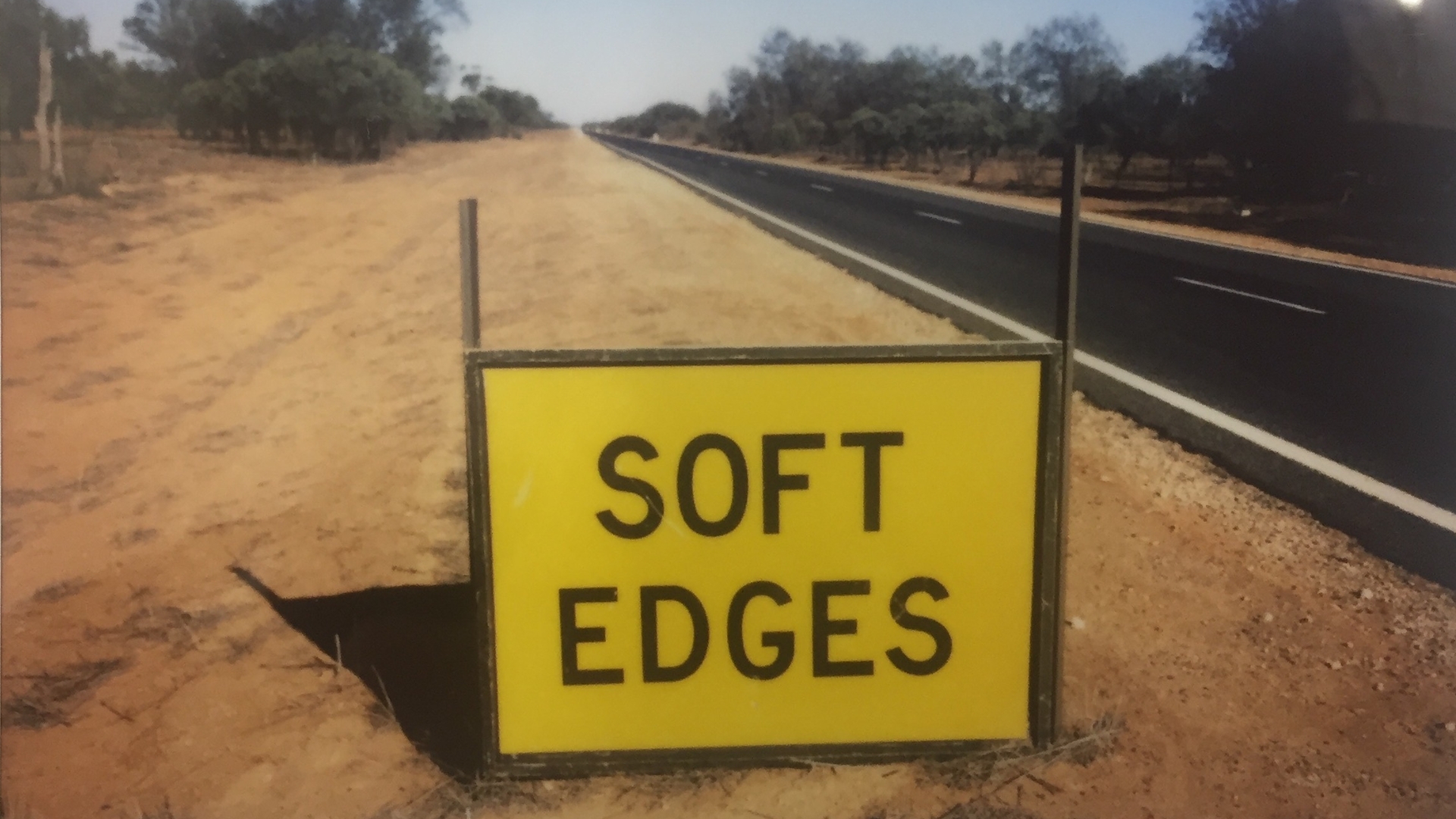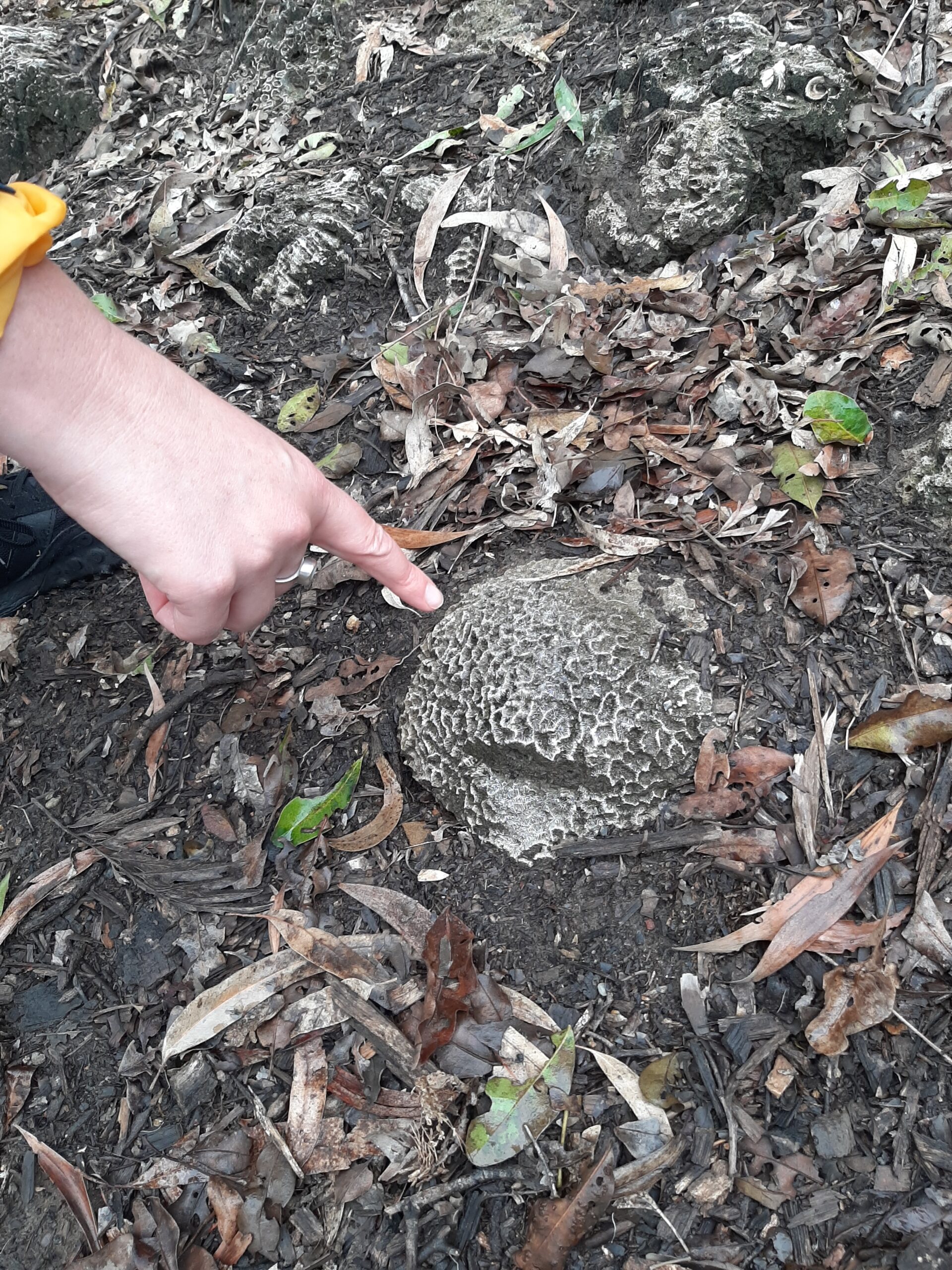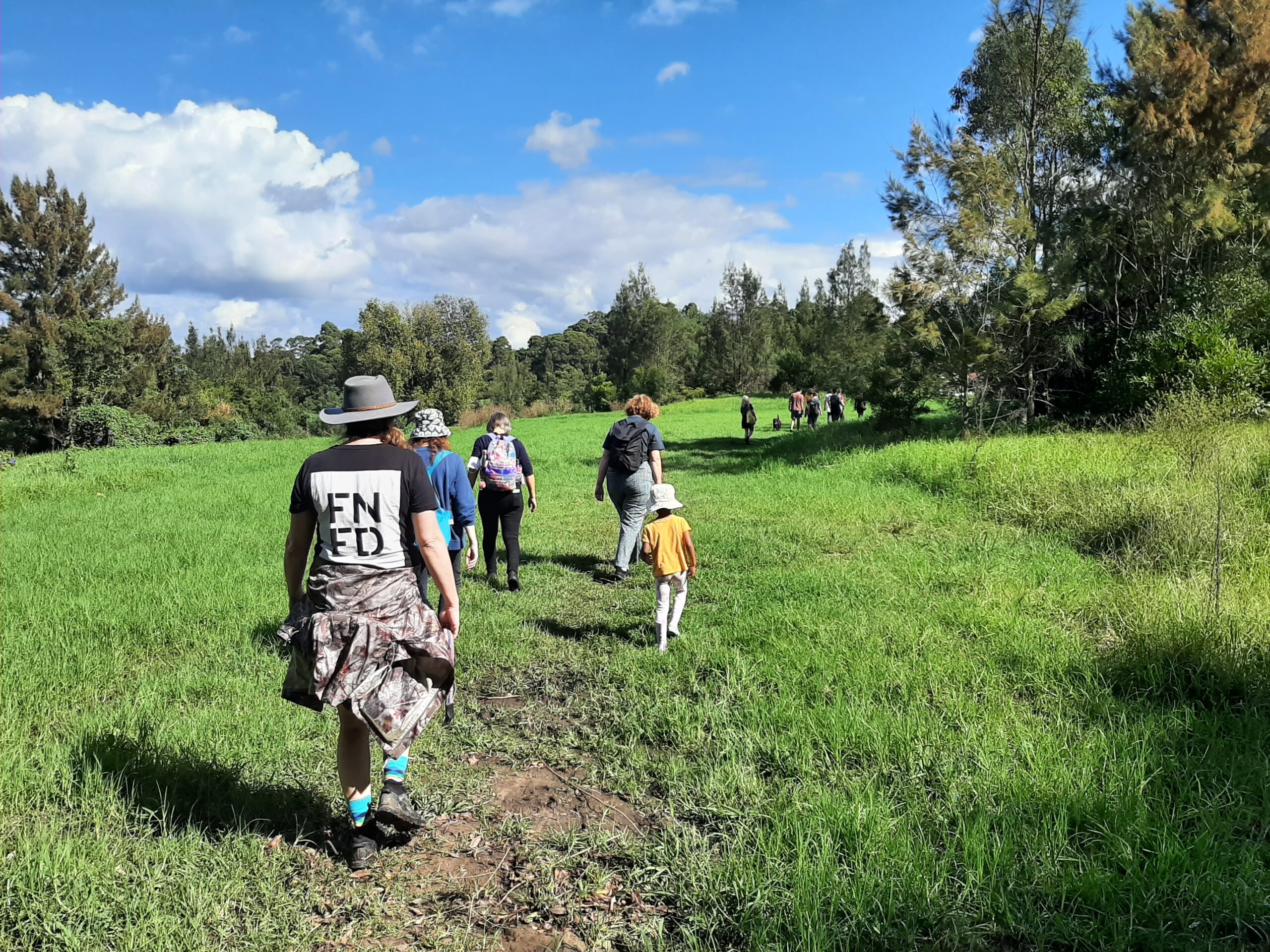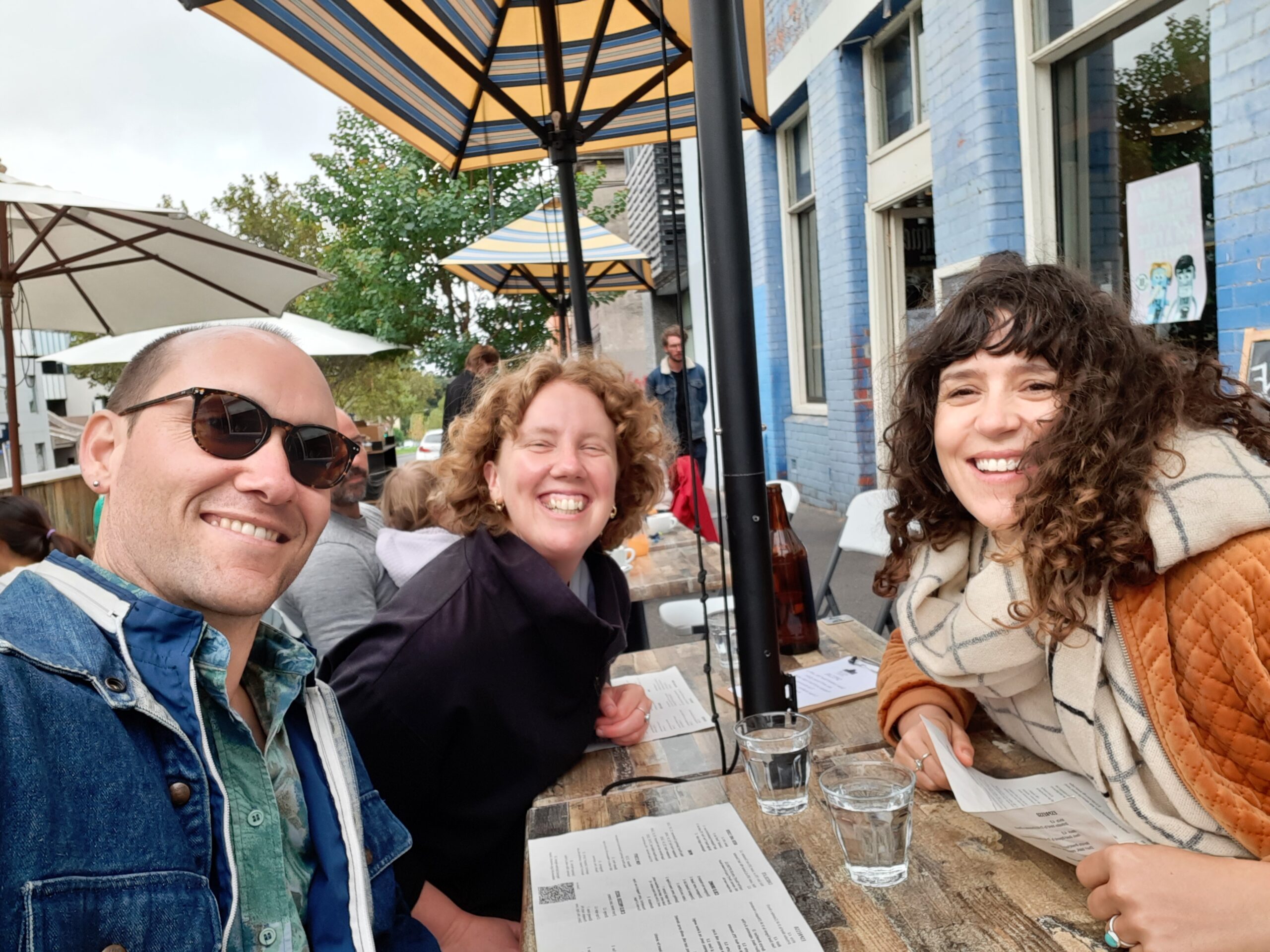Magnetic Topographies is an interdisciplinary working-group organised by Therese Keogh, Clare Britton and Kenzee Patterson that brings together people with diverse areas of interest and from varying fields, with an underlying focus on collective spatial practice. It is strange and pertinent thinking about materiality, geography and excess while images of people buried under rubble for fighting for their land circulate across our phone screens in almost live, razor-sharp definition. This genocide for years to come will be pushing us into the well of our collective memory to grapple with questions about our failed institutions, relationships to each other and the policies of overaccumulation and expansion that led us here. For now, the opportunity to develop a deeper, more active relationship with our landscape still exists – something that should not be taken for granted. Like touching nude soil, the connection is proximate, intimate, body to body, skin to skin, strangely corporeal and ethereal at the same time. For Magnetic Topographies, a social practice becomes a place-based practice becomes a compost made up of new friendships and knowledge. A practice that is playfully unassuming yet deeply anti-institutional: meet your friends, go for a walk, see what happens.

Barkandji Country, August 2018, Photo by Clare Britton.
SSA: I’m interested to hear about how Magnetic Topographies came to be. What led to this working group and what were the main concerns you were interested in tackling at that time?
TK: Where's the beginning point exactly? It’s difficult to pinpoint! The three of us met when we began our Masters at the Sydney College of the Arts. Our studios were near each other, we shared supervisors and attended the same reading groups together. Eventually we became friends and realised our shared interest in thinking about what it means to work in dialogue with a place and with other creative practitioners in those places. Then, when we finished up, we all went our separate ways. Kenzee was living in Broken Hill for some time and Clare and I went out on this epic road trip to visit him there. The ARI that Kenzee ran was based in an old IGA, is that right?
KP: Yeah, it was known as “Everybody’s IGA”. The ARI was called Cosmopolitan Decline. I ran it as a studio space but also a place where the local community could gather. I had set up a little reference library and hosted screenings and events there. Therese and Clare came out and participated in an exhibition along with some local artists in around June 2018.
TK: Yeah, that was still a while back then. We obviously kept in touch and then when COVID-19 hit, we were all living in various places and were trying to maintain a creative community through that time and continue to think about the concerns that we were individually and collectively mulling over. So that's when we started thinking about this thing called Magnetic Topographies in a more formal way.

CB: I’d like to begin with a quote that comes from the recent collaboration called A River Ends as the Ocean: Walk the Tide Out between Aunty Rhonda Dixon Grovenor, Astrida Neimanis and I, that we published through Magnetic Press. There's this part where Astrida talks about origin stories and she says:
‘Origin stories have their value, but they're as compelling as they are dangerous. On the one hand, they seduce us with the promise of meaning. How something begins can tell us an awful lot about where it ends up. But on the other hand, origin stories are prone to self-fulfilment. All origin stories are anachronous after all. We only see the beginning once we’ve travelled downstream and tend to look back over our shoulder, “ah, that's how I got here”.’
I love those words of hers. Through all of these different kinds of tendrils and beginnings coming together, I feel like I developed a real connection with Therese and Kenzee around considering what it means to grow up in a colonised place and trying to find ways of living more ethically. It was imperative to find relationships to place and to other artists in this context, recognising where my own expertise ends and someone else's begins. I was interested in multivocal perspectives and developing a sense of understanding of the place that is layered and complicated. That was definitely a concern of mine.
SSA: What other thinking led to you starting Magnetic Topographies?
KP: The idea of artists supporting other artists is an ethos that I've maintained for the duration of my practice. I have been involved with running two physical spaces. One in Sydney called Locksmith Project Space, which I ran with a few friends soon after finishing my undergraduate degree. Then, when I moved to Broken Hill, I saw the IGA space that became available there and immediately knew that I wanted to share it with other people. I wanted to create a space of exchange between me and the local community, non-artists and artists alike. And that space was called Cosmopolitan Decline. The name comes from an open cut mine that still exists in Broken Hill. The ‘cosmopolitan decline’ was the name of one of the ramps that leads you down into the Cosmopolitan Mine. So the title gave way for me to think about how going underground could provide a kind of model for thinking about the entanglements of commodities, communities and material spatial practice.

CB: Differently to Kenzee and Therese, I started off working in performance which is an inherently collaborative form. As I was moving into a studio practice, it was very different from working in a rehearsal room and being part of a creative conversation that's happening in that live moment. Luckily, our supervisors included artists like Bianca Hester and Mikala Dwyer who share a very collaborative ethic and helped put us in dialogue with each other. Through working with Therese and Kenzee, I was able to develop an open and collaborative relationship rooted in trust. I was able to say, ‘I really don’t know what I think about this, would you think with me?’. And I guess that’s the incredible thing about participating in a reading group. When you read something with others, you see how differently they may read the same text. It's just an endlessly fascinating process. In terms of making work as artists, we're not just interested in creating an object but rather trying to understand things together and create a community that we're feeding into and that we are a part of.
TK: Looking at the image behind you, Clare, I think mentioning the Cooks River as your collaborator might be good (giggles). The river has been the love of Clare's life for the past however many years.
CB: Sad but true…Yes! I have been focused on a very beautiful and toxic urban river that moves down through the suburbs of Sydney and the Lands of the Wangal, Gameygal, Gadigal and Bidjigal people down to Botany Bay, the site of Australian colonisation. In around 2011, I completed a big project, researching Jimmy Governor, my family history and particularly the place where my mom grew up. Posts in the Paddock was an interdisciplinary, collaborative conversation that was supported by Moogahlin Performing Arts and My Darling Patricia. I learned so much from that process. When I went to study again, I had a desire to understand the history, the depth and culture of the place where I lived, which was near that river.
Cooks River is about 23 kilometres long and because it’s made of water, it doesn’t really have a fixed beginning or an end. Interestingly, the mouth of the river has been rerouted about a kilometre or so to make way for the Sydney Airport. The river changes every day through tidal changes, changes in water levels through the rain. It gathers up all the stormwater of the city, so it is like looking down the back of Sydney’s couch and seeing the stuff that gets collected there.
TK: I had just finished a Masters in Geography from Queen Mary University of London and found myself back in Australia quite suddenly because of the pandemic. A few years prior to coming back, I had completed a project down on Wodi Wodi and Dharawal Country with some landscape architects and artists, looking at decommissioned coal mine sites in the Illawarra region and thinking about the extraction of coal.
I was interested in investigating the kinds of material excesses that are produced from this process and the ways in which we are collectively living in those excesses all of the time. Also, how we might think about the different kinds of social relationships that emerge on the periphery of the overspills or the things that we aren’t actually looking for. And then I started thinking about the relationship between material practice and writing through geography. The word geography literally means ‘earth-writing’ and so I started thinking about what it means to write the earth and how that relationship between the earth and writing might be written differently, and that being a collective task.
By the time we started Magnetic Topographies, I had done a bunch of collaborative work, organising a writing group called Written Together and co-facilitating a group called Incubating Imaginaries. So collaborative working groups had become more and more central to the ways in which I work and practise.
CB: And then the Composting Feminisms reading group organised by Jennifer Mae Hamilton and Astrida Neimanis had helped to unlock some principles for us as well. The reading group’s name likens developing knowledge to a compost pile, meaning it is not a neat, clean process. It’s an active, sticky, fecund and difficult space that pushes its participants to accept the complexity that comes with learning. And that difficulty and discomfort is productive.
SSA: I love that. From looking at your website, I had a sense that Magnetic Topographies is imbued with this kind of inexplicit opportunity to foster new tools for being and relating to one another that is necessary for our survival. For example, accepting the challenges that may come from collaboration or sharing space.
KP: I don’t necessarily think that we are setting out to create novel modes of existence. Rather, we are drawing on other systems that exist currently but are maybe not the dominant systems of power that shape how we live. Creating these spaces through hosting reading groups, excursions or meals – particularly with people from different backgrounds – provides this interstitial space that is away from the institution, that is informal. This makes for a really productive space to think about how things can be different, and brings different perspectives to bear on some of our concerns.
TK: A lot of it is also about friendship, which is not something that should be taken for granted. Like learning, it is a process that requires investment. There is this quote by Black, queer-feminist writer, Ashon T. Crawley from their book called The Lonely Letters, where they write about friendship as a kind of anti-institutional practice:
‘This closure comes through friendship, which is another way to say sociality, another way to think vibration. The inventive impulse of friendship emerges from the fact that it is not institutionally informed or produced or protected. It's not like marriage where there are ceremonies and rituals that people perform in order to enter into it, it's not like marriage where there are institutions that give or withhold people's capacities for engaging the practice. Friendship is anti-institutional. People entering into such a relation must be committed to figuring out what that mode of existence will be, how they will behave, what rules to establish by which to abide. Seems to me that friendship is one such thing we are constantly after as otherwise possibility. It's a mode for constituting otherwise ways of being in the world.’
I guess this is what Magnetic Topographies is also about!

SSA: I wanted to briefly touch on the text that contributed to your thinking around Magnetic Topographies titled Ground Provisions by Stefano Harney and Tonika Sealy Thompson. How do you reflect on that text over time? There is a section that talks about how the modern education system splits learning into piecemeal work (such as requiring students to complete their reading at home rather than in the class) likening it to a feature of capitalism and the practice of outsourcing work to consultants.
TK: It is really good to talk about Ground Provisions because the ideas in that text are still percolating in the way that we're thinking together. I agree that the outsourcing of learning within the education system is an issue. But it is also important to recognise that there are many roles that each of us adopts within the institutional ecology of education, where I've been a student in multiple spaces, but I also teach in multiple spaces and work across many disciplines. There’s a lot of through traffic across these various kinds of labour. Magnetic Topographies and collaborative projects definitely allow us to create spaces where we can do things differently.
CB: So often it feels like you're behind the eight ball if you haven't done the right readings or prepared enough for the class. The process described in Ground Provisions allows for this labour of grappling with ideas to happen alongside other people and not necessarily get forced into one’s private time. It is interesting to consider what new possibilities would emerge if we read things together. This is certainly something that we experienced through Magnetic Topographies – how the same text can be read so differently in dialogue with others.
SSA: Absolutely. Another idea in Ground Provisions that I found really compelling is the writers’ commitment to travelling and supporting the ‘Afro-Asian century’. Given our geography in the Asia-Pacific region, I’m curious to hear your reflections on this commitment and whether this is a value that we could see properly manifested here in Australia.
TK: It’s great to see creative communities in Australia more actively engaging in cultural dialogue with neighbours in the Asia-Pacific. In the current context, I think that there is a real re-framing and recognition of where creative practices and creative communities lie. I also think there is a pretty major reckoning and decentring of geographies that is happening right now and that will reshape the realities in which we practise. But it is also important to recognise that in the process of colonisation, Australia-as-nation-state became a colonising force elsewhere. An anti-colonial model requires us to investigate global colonial relations that continue to produce powers of dominance in our governance systems, by creating space for international solidarities and coalitions, so that we might be able to scale up an otherwise of friendship.
un Projects’ Editor-in-Residence Program is supported by the City of Yarra, Creative Victoria and City of Melbourne.
Editor
